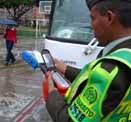Feb 26, 2004In Bogotá, Colombia, 23,000 privately owned transit buses now sport RFID tags made by Identec Solutions. As a result, the city’s residents have seen their daily commute times slashed by 75 percent and enjoy improved transportation services.
For years, Bogotá and its 6,771,000 residents had been looking for a way to end the major traffic congestion caused by the operation of the city’s privately owned busses. These busses had consistently left less profitable routes and areas to converge on major thoroughfares where they could compete for the bulk of riders. This left other areas of the city without bus service and resulted in massive congestion that could add hours to residents’ commutes.
Faced with trying to fix the problem, last year Bogotá's Secretary of Transit and Transportation issued a regulation stating that each transit bus must be equipped with an RFID tag. In addition, busses were allocated specific regions and streets in which to operate.
The RFID system uses Identec’s Intelligent Long Range RFID system, with an Identec active i-Q tag attached to the dashboard of each bus. The five- by one- by 3/4-inch tags operate at 916.5 MHz. According to Identec, its technology was selected by the majority of systems integrators bidding for the bus contract.
“In the final round of tendering, three of the five companies bidding for the contract proposed using our product,” says Ray Braun, vice president of operations at Identec Solutions, which is based in Kelowna, British Columbia.
Policing the buses, transit officers use rugged PDA’s fitted with Identec’s PC card RFID readers. In an operation similar to some radar speed traps, transit officers can set up random inspection points to check that a bus’s RFID tag ID matches up with the city region assigned to that bus. So far, 50 reader-equipped PDAs have been issued.
Each deployed tag carries 8 kilobytes of memory and data consisting solely of unique ID of the bus to which it is attached. The reader-equipped PDAs hold a database of each buses licensed route. If a bus is found to be out of its license area, then the officer can immediately issue a fine.
Officers have no need to board a bus in order to read the tag. According to Identec, the Bogotá Transit and Transportation technical specification for the RFID system was that a tag could be read at a range of three meters (10 feet). The company maintains its tags can be read at up to 91 meters (300 feet).
Colombian systems integrator WM Wireless & Mobile won the public tender for the contract in a joint bid with Identec. The scope of the project was to provide 23,000 tags and 50 readers plus the software application that runs on the handheld units. WM Wireless & Mobile began installing the system in November 2003 and is expected to complete the installation this month.
According to Identec, implementation of the system has already reduced the average daily commute time from four hours to one. Armed with Identec-provided tools, transit officers now can ensure commercial vehicles remain in the areas they are assigned and restricted to. By doing so, they have eliminated congestion on the main thoroughfares, which is key to reducing the daily commutes.
“It is a long narrow city in a valley and there are only a few main roads that, if they become congested, affect the other roads that feed into them as well,” says Braun.
Attend RFID Journal Live! 2004
Executive Conference, Chicago, March 29 to 31
It's Where RFID Is Happening
Register Today


